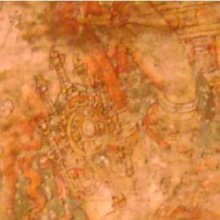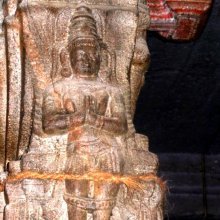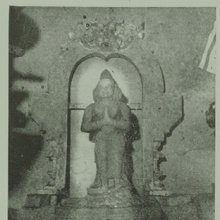Shame, Same: 12 definitions
Introduction:
Shame means something in Buddhism, Pali, Hinduism, Sanskrit, the history of ancient India, Jainism, Prakrit, biology. If you want to know the exact meaning, history, etymology or English translation of this term then check out the descriptions on this page. Add your comment or reference to a book if you want to contribute to this summary article.
Images (photo gallery)
(+196 more images available)
In Hinduism
Natyashastra (theatrics and dramaturgy)
Source: Shodhganga: Elements of Art and Architecture in the Trtiyakhanda of the Visnudharmottarapurana (natya)Shame is associated with Utsaṅgahasta: one of the thirteen Combined-hand Gestures (in Indian Dramas) (known as saṃyuktahastas), according to the Viṣṇudharmottarapurāṇa, an ancient Sanskrit text which (being encyclopedic in nature) deals with a variety of cultural topics such as arts, architecture, music, grammar and astronomy.—According to the Śabdakalpadruma, the word utsaṅga means embrace. In the utsaṅga posture, hands are in arāla position and the palm upwards and overturned and this posture shows the touch of other. In the Abhinayadarpaṇa, the utsaṅga posture is suggested to denote embrace as the word itself means. Moreover this posture is also used to show shame, displaying ornaments, and teaching of boys.

Natyashastra (नाट्यशास्त्र, nāṭyaśāstra) refers to both the ancient Indian tradition (shastra) of performing arts, (natya—theatrics, drama, dance, music), as well as the name of a Sanskrit work dealing with these subjects. It also teaches the rules for composing Dramatic plays (nataka), construction and performance of Theater, and Poetic works (kavya).
In Buddhism
Theravada (major branch of Buddhism)
Source: Pali Kanon: Manual of Buddhist Terms and Doctrineshiri.
Theravāda is a major branch of Buddhism having the the Pali canon (tipitaka) as their canonical literature, which includes the vinaya-pitaka (monastic rules), the sutta-pitaka (Buddhist sermons) and the abhidhamma-pitaka (philosophy and psychology).
India history and geography
Source: Project Gutenberg: Castes and Tribes of Southern India, Volume 1Same (“millet (panicum miliare)”) is one of the exogamous septs (divisions) among the Kurubas (a tribe of South India). The Kurubas are sub-divided into clans or gumpus, each having a headman or guru called a gaudu, who gives his name to the clan. And the clans are again sub-divided into gotras or septs (viz., Same).

The history of India traces the identification of countries, villages, towns and other regions of India, as well as mythology, zoology, royal dynasties, rulers, tribes, local festivities and traditions and regional languages. Ancient India enjoyed religious freedom and encourages the path of Dharma, a concept common to Buddhism, Hinduism, and Jainism.
Biology (plants and animals)
Source: Google Books: CRC World Dictionary (Regional names)Shame in India is the name of a plant defined with Panicum sumatrense in various botanical sources. This page contains potential references in Ayurveda, modern medicine, and other folk traditions or local practices It has the synonym Panicum attenuatum (Moench) Moench (among others).
Example references for further research on medicinal uses or toxicity (see latin names for full list):
· Grasses of Ceylon (1956)
· The Flora of British India (1896)
· Revised Handbook to the Flora of Ceylon (1931)
· Tropical Crops: Monocotyledons (1972)
· Blumea (1989)
· Tableau Encyclopédique et Méthodique … Botanique (1791)
If you are looking for specific details regarding Shame, for example chemical composition, diet and recipes, pregnancy safety, side effects, extract dosage, health benefits, have a look at these references.
Source: Google Books: CRC World Dictionary (Regional names)1) Same in India is the name of a plant defined with Acacia polyacantha in various botanical sources. This page contains potential references in Ayurveda, modern medicine, and other folk traditions or local practices It has the synonym Gagnebina tamariscina sensu Bojer (among others).
2) Same is also identified with Echinochloa frumentacea It has the synonym Oplismenus frumentaceus (Link) Kunth (etc.).
3) Same in Nigeria is also identified with Sorghum bicolor It has the synonym Holcus saccharatus var. technicus (Körn.) Farw. (etc.).
4) Same in South America is also identified with Carpotroche brasiliensis It has the synonym Carpotroche brasiliensis (Raddi) A. Gray, isonym (etc.).
Example references for further research on medicinal uses or toxicity (see latin names for full list):
· Journal of Ethnopharmacology (2006)
· Novosti Sistematiki Vysshikh Rastenii (1968)
· Prodromus stirpium in horto ad Chapel Allerton vigentium. (1796)
· Flora Indica (1832)
· Prodromus Plantarum Capensium, … (1794)
· Journal of the American Chemical Society (1938)
If you are looking for specific details regarding Same, for example side effects, health benefits, pregnancy safety, diet and recipes, extract dosage, chemical composition, have a look at these references.

This sections includes definitions from the five kingdoms of living things: Animals, Plants, Fungi, Protists and Monera. It will include both the official binomial nomenclature (scientific names usually in Latin) as well as regional spellings and variants.
Languages of India and abroad
Sanskrit dictionary
Source: DDSA: The practical Sanskrit-English dictionarySame (समे).—2 P.
1) To come together or meet; समेत्य च व्यपेयाताम् (sametya ca vyapeyātām) H.4.69.
2) To go through, march across.
Source: Cologne Digital Sanskrit Dictionaries: Cappeller Sanskrit-English DictionarySame (समे).—approach together, gather, assemble at or in ([accusative] or [locative]); meet, encounter ([instrumental] ±samam); marry ([instrumental]); come near, go to, enter ([accusative]).
Same is a Sanskrit compound consisting of the terms samā and i (इ).
Source: Cologne Digital Sanskrit Dictionaries: Monier-Williams Sanskrit-English DictionarySame (समे):—[=sam-e] (-ā 5 √i) [Parasmaipada] -aiti ([present participle] -eyāna, [Mahābhārata]), to come together, approach together, meet at or in ([accusative] or [locative case]) or with ([instrumental case] with or without samam), go to or across, arrive at ([accusative]), [Ṛg-veda] etc. etc.;
—to unite with ([instrumental case]) in marriage, [Rāmāyaṇa];
—to enter, [Hitopadeśa];
—to emulate, cope with ([accusative]), [Rāmāyaṇa];
— (with yogam) to lead or join together, form an alliance between ([genitive case]) and ([instrumental case]), [Śvetāśvatara-upaniṣad] (= saṃ-gamayya, [Śaṃkarācārya])
Source: DDSA: Paia-sadda-mahannavo; a comprehensive Prakrit Hindi dictionary (S)Same (समे) in the Sanskrit language is related to the Prakrit word: Same.
Sanskrit, also spelled संस्कृतम् (saṃskṛtam), is an ancient language of India commonly seen as the grandmother of the Indo-European language family (even English!). Closely allied with Prakrit and Pali, Sanskrit is more exhaustive in both grammar and terms and has the most extensive collection of literature in the world, greatly surpassing its sister-languages Greek and Latin.
Prakrit-English dictionary
Source: DDSA: Paia-sadda-mahannavo; a comprehensive Prakrit Hindi dictionarySame (समे) in the Prakrit language is related to the Sanskrit word: Same.
Prakrit is an ancient language closely associated with both Pali and Sanskrit. Jain literature is often composed in this language or sub-dialects, such as the Agamas and their commentaries which are written in Ardhamagadhi and Maharashtri Prakrit. The earliest extant texts can be dated to as early as the 4th century BCE although core portions might be older.
Kannada-English dictionary
Source: Alar: Kannada-English corpusŚame (ಶಮೆ):—[noun] = ಶಮ [shama].
Source: Alar: Kannada-English corpusSame (ಸಮೆ):—
1) [verb] to make; to build; to construct.
2) [verb] to prepare; to make ready.
3) [verb] to form an image by chiseling a stone; to carve; to sculpture.
4) [verb] to be constructed, built.
5) [verb] to write, compose (a literary work).
6) [verb] to prepare food by cooking; to cook.
7) [verb] to happen; to take place.
--- OR ---
Same (ಸಮೆ):—
1) [verb] to be used up or expend completely; to be exhausted.
2) [verb] to be destroyed.
3) [verb] to be worn out (as from continuous or long usage).
4) [verb] to become weak; to lose strength.
5) [verb] (time) to pass; to elapse.
6) [verb] to become thin; to lose much flesh or weight.
7) [verb] to be reduced (in size, intensity, etc.).
8) [verb] to be utilised, used.
9) [verb] to feel distresed in the mind; to worry.
10) [verb] to destroy completely; to erase; to eradicate.
--- OR ---
Same (ಸಮೆ):—[noun] a metal stand that holds a lamp or lamps.
--- OR ---
Sāme (ಸಾಮೆ):—
1) [noun] the grass Echinochloa frumentacea ( = Panicum frumentaceum) of Poacea family.
2) [noun] its grain.
3) [noun] another grass Panicum miliare of the same family.
Kannada is a Dravidian language (as opposed to the Indo-European language family) mainly spoken in the southwestern region of India.
See also (Relevant definitions)
Partial matches: Sam, I, E, Cama, Sama.
Starts with: Shame bush, Shame plant, Shame weed, Shame-gadde, Shamee, Shamegadde, Shamei, Shamel, Shamela, Shamelessness, Shamepsu, Shameshvaranatha, Shameya.
Ends with: Akshame, Dushshame, Dyavakshame, Kshame, Prashame, Sushamasushame, Sushame, Upasame, Vishame.
Full-text (+13934): Lajja, Vrida, Dhik, Trapa, Vailakshya, Sama, Sarupa, Sajati, Salokya, Vilakshatva, Apatrapa, Hrepana, Sagotra, Paribhavuka, Savidha, Salajja, Savarna, Che, Ritiya, Hlika.
Relevant text
Search found 536 books and stories containing Shame, Same, Samē, Sam-e, Samā-i, Sama-i, Śame, Sāme, Saame; (plurals include: Shames, Sames, Samēs, es, is, Śames, Sāmes, Saames). You can also click to the full overview containing English textual excerpts. Below are direct links for the most relevant articles:
Paduka-panchaka (the five-fold footstool) (by Arthur Avalon)
Kathasaritsagara (the Ocean of Story) (by Somadeva)
The “entrapped suitors” motif < [Notes]
The ten stages of love-sickness < [Notes]
The use of riddles in eastern fiction < [Notes]
Manusmriti with the Commentary of Medhatithi (by Ganganatha Jha)
Verse 12.92 < [Section X - The Highest Good]
Verse 4.26 < [Section VI - The Harvest-Sacrifice]
Verse 11.176 < [Section XIX - Expiation for Wrongful Sexual Intercourse]
Two Short Stories < [January 1954]
‘Panchali Sapatham’: An Epyllion < [January – March, 1982]
A Telugu Sage! < [April – June, 1997]
A History of Indian Philosophy Volume 2 (by Surendranath Dasgupta)
Part 13 - Logical Speculations and Terms relating to Academic Dispute < [Chapter XIII - Speculations in the Medical Schools]
Part 17 - Good Life in Caraka < [Chapter XIII - Speculations in the Medical Schools]
Part 8 - The Ethics of the Gītā and the Buddhist Ethics < [Chapter XIV - The Philosophy of the Bhagavad-gītā]
Bhajana-Rahasya (by Srila Bhaktivinoda Thakura Mahasaya)
Related products
(+46 more products available)











